Welcome to London Grip, a forum for reviews of books, shows & events – plus quarterly postings of new poetry. Our most recent posts are listed below. Older posts can be explored via the search box and topic list. For more information & guidelines on submitting reviews or poems please visit our Home page.
We are lucky that the Hispanic Society Museum and Library in Upper Manhattan is closed for refurbishing so that the collection that the philanthropist Archer M. Huntington accumulated in the late 19th and early 20th centuries can travel the world on loan. The exhibition at the RA displays more than 150 pieces, displayed in chronological order, that range from ceramics to metalwork, textiles, paintings and more that have been collected across four millennia. There is a wide cultural assortment, from prehistoric artefacts to modern art. Influences of Catholic Spain combine with those of Celtic, Jewish and Islamic art as well as Indigenous American cultures. The racial purity (limpieza de sangre) that the royals Ferdinand II of Aragon and Isabel I of Castile claimed in the late 15th century, when they finally conquered Granada and freed it from the Arab rule, is therefore questioned via the richness and variety of this important collection. The sovereigns forced Muslims and Jews to convert or they were forced to leave the country. This impoverished the nation, as Jewish and Islamic communities were wealthy and cultivated, but their culture and art survived, mixing with the dominant Christian faith.
Thus, the objects on display defy being labelled; they are the result of Huntington’s passion for Spanish culture that started when he was a young boy. Indeed, when he was only twelve, he read a book about the Roma community in Spain that he had bought in Liverpool on one of his visits to Europe with his family. His father, Collis P. Huntington, was a wealthy industrialist, and his mother, Arabella Huntington, influenced his cultural interests. Huntington devoted most of his life to the study of the languages and cultures of the Hispanic world; he included Central and South America as well, which expanded the geographical range of his studies, and he attended lectures too. It seemed to him as if he had discovered a ‘new world’, and he approached it with the interest of a scholar and the experience of an entrepreneur. In the process of collecting the different objects, he was influenced by the example of the British Museum, which has both a library and an art gallery. In 1902 he acquired Jerez’s collection of literary and historical volumes and purchased different kinds of objects from dealers and art auctions. Decorative art objects, antiquities, Islamic and Christian works, textiles from Latin America and Al-Andalus, the area in the south of Spain ruled by Arabs, furniture, ceramics and silverwork are displayed side by side with paintings by Spanish masters such as El Greco, Diego Velázquez and Francisco Goya as well as more recent painters. This approach gives a comprehensive vision and understanding of the Hispanic world, its people and costumes and how they lived. Spain was invaded by the Romans, who ruled for five centuries. Then the Visigoths established their kingdom, which was replaced by Arab rule that lasted for nearly eight hundred years, though towards the end it was limited to the south of Spain. Spain had its moments of glory during the Golden Age (Siglo de Oro) in the 16th and 17th centuries, when art and literature flourished and Central and South America were targets for Spain’s colonization efforts after Cristoforo Colombo’s ‘discovery’ and Amerigo Vespucci’s explorations of the ‘new world’.
Huntington’s vision is broad, multifaceted and contradictory; it reflects his tastes and his pioneering approach as well as the trends of the time, that is, the wish to keep hold of our memory of the past. Huntington also purchased pictures from two artists who are now considered to have produced the best examples of early twentieth century Spanish art, Joaquin Sorolla and Ignacio Zuloaga. Sorolla conveys the sunlit reality of Spain while Zuloaga has a darker vision in terms of both his colour palette and his themes. Huntington also commissioned Sorolla to produce the cycle Vision of Spain; it consists of fourteen large canvases that explore the customs and traditions of the different regions and peoples of Spain (1911–19). The exhibition displays some large sketches made in gouache on paper that give an idea of Sorolla’s monumental work.
The Bell-shaped ceramics of the Beaker culture (2400–1900 BC) and the Celtiberian metal work of the Palencia hoard (172–50 BC) open this stimulating exhibition. Geometric-patterned textiles in red, gold and green silk threads and lustreware ceramics with a reflective glaze show the complexity of Islamic art that led to the production of unique pieces. On the other hand, the Catholic art produced after the Reconquista (the reconquest from the Arab rule) is fascinating because of its intense but predictable iconography, such as Andrea de Mena’s ‘Madre Dolorosa’ and ‘Ecce Homo’ (1675). Important artworks by El Greco, ‘The Penitent St Jerome’ (1600) and ‘Pietà’ (1574–76), and the ‘Immaculate Conception’ (1670) by Juan Carrero de Miranda confirm the deeply rooted religious influence that in El Greco’s work acquires a nuanced spiritual and personal style. A more secular view can be seen in the work of Velázquez, ‘Portrait of a Girl’ (1638–42), and in Francisco de Zubarán’s ‘St Emerentiana’ (1635-40). Velázquez’s portrait is one of the most remarkable pieces in the exhibition; it depicts the little girl in an insightful way – her dress is barely sketched and the focus is on her gaze, her soft skin and her hair. The whole piece conveys cleverness and an intensity of feelings.
The three sections on Colonial Latin America (‘People and Place’, ‘Decorative Art’ and ‘Religious Art’) feature interesting maps of the world and of the people and animals living in Latin America as well as everyday objects such as portable writing cabinets in Mexican lacquer that are decorated in bright colours (1650–99). The captions highlight the obsession with racial purity; the population was forcibly divided into groups according to their skin colour. People with white skin were placed at the top of the hierarchy, creole people were next, and then mestizos (people with mixed parentage), and Indigenous people and enslaved Africans were positioned at the bottom. It is significant that Indigenous artists adapted their art to European tastes without relinquishing their heritage. They used local material to produce hybrid objects, and an astounding example of this is a large tray from Los Galgos’ workshop (Mexico, 18th century), probably used as a centre piece for a table, depicting Indigenous iconography of local flowers and birds painted with organic pigments. A fabulous silk shawl with geometric and flowery patterns in bright yellows, reds and greens with silver and golden threads shows the outstanding achievements of Indigenous artists and craftspeople.
The religious section features traditional pieces as well as unusual ones that have retained traces of pre-Columbian symbols and materials, such as the altar lamp (1675), búcaros from Chile, and the depiction of the four states of humanity, ‘Death’, ‘Soul in Hell’, ‘Soul in Purgatory’ and ‘Soul in Heaven’ (1775). These four pieces reflect the Church’s teaching; however, the exaggerated dramatic poses of the figures suggest connections to the Indigenous world rather than to the severe style of Spanish Catholic art.
A special mention is due to the impressive work on display by Goya. His famous ‘Duchess of Alba’ (1797) is a masterpiece of all time. The sketchy and yet precise rendering of the black lace gown, the clever ironic gaze and the index finger pointing to the inscription on the sand, ‘solo Goya’ (only Goya), are mysterious and engaging. The status of the woman in the painting and the implications of her position in society are clearly shown in her attire. However, the focus seems to be on her attitude, which is depicted in her pose and her facial features and expressed in her gaze. They convey a sense of control, self-awareness and a life lived with a pinch of irony. Alongside the artworks of Sorolla and Zuloaga, ‘Girls of Bunian’ by Ermenegildo Anglada Camarasa communicates the folkloric essence of Spanish culture, counterbalancing the austere darkness of the aristocratic elite.
The exhibition is an extensive display of the diverse and enthralling faces of Hispanic art that developed in Spain and Latin America throughout millennia. Huntington’s pioneering experiment reveals a clever understanding and a constant dedication to such cultures that absorbed ideas and techniques from different sources and heritages, resulting in a unique corpus of works.
Spain and the Hispanic World
Royal Academy of Arts
Until 10 April.
We are lucky that the Hispanic Society Museum and Library in Upper Manhattan is closed for refurbishing so that the collection that the philanthropist Archer M. Huntington accumulated in the late 19th and early 20th centuries can travel the world on loan. The exhibition at the RA displays more than 150 pieces, displayed in chronological order, that range from ceramics to metalwork, textiles, paintings and more that have been collected across four millennia. There is a wide cultural assortment, from prehistoric artefacts to modern art. Influences of Catholic Spain combine with those of Celtic, Jewish and Islamic art as well as Indigenous American cultures. The racial purity (limpieza de sangre) that the royals Ferdinand II of Aragon and Isabel I of Castile claimed in the late 15th century, when they finally conquered Granada and freed it from the Arab rule, is therefore questioned via the richness and variety of this important collection. The sovereigns forced Muslims and Jews to convert or they were forced to leave the country. This impoverished the nation, as Jewish and Islamic communities were wealthy and cultivated, but their culture and art survived, mixing with the dominant Christian faith.
Thus, the objects on display defy being labelled; they are the result of Huntington’s passion for Spanish culture that started when he was a young boy. Indeed, when he was only twelve, he read a book about the Roma community in Spain that he had bought in Liverpool on one of his visits to Europe with his family. His father, Collis P. Huntington, was a wealthy industrialist, and his mother, Arabella Huntington, influenced his cultural interests. Huntington devoted most of his life to the study of the languages and cultures of the Hispanic world; he included Central and South America as well, which expanded the geographical range of his studies, and he attended lectures too. It seemed to him as if he had discovered a ‘new world’, and he approached it with the interest of a scholar and the experience of an entrepreneur. In the process of collecting the different objects, he was influenced by the example of the British Museum, which has both a library and an art gallery. In 1902 he acquired Jerez’s collection of literary and historical volumes and purchased different kinds of objects from dealers and art auctions. Decorative art objects, antiquities, Islamic and Christian works, textiles from Latin America and Al-Andalus, the area in the south of Spain ruled by Arabs, furniture, ceramics and silverwork are displayed side by side with paintings by Spanish masters such as El Greco, Diego Velázquez and Francisco Goya as well as more recent painters. This approach gives a comprehensive vision and understanding of the Hispanic world, its people and costumes and how they lived. Spain was invaded by the Romans, who ruled for five centuries. Then the Visigoths established their kingdom, which was replaced by Arab rule that lasted for nearly eight hundred years, though towards the end it was limited to the south of Spain. Spain had its moments of glory during the Golden Age (Siglo de Oro) in the 16th and 17th centuries, when art and literature flourished and Central and South America were targets for Spain’s colonization efforts after Cristoforo Colombo’s ‘discovery’ and Amerigo Vespucci’s explorations of the ‘new world’.
Huntington’s vision is broad, multifaceted and contradictory; it reflects his tastes and his pioneering approach as well as the trends of the time, that is, the wish to keep hold of our memory of the past. Huntington also purchased pictures from two artists who are now considered to have produced the best examples of early twentieth century Spanish art, Joaquin Sorolla and Ignacio Zuloaga. Sorolla conveys the sunlit reality of Spain while Zuloaga has a darker vision in terms of both his colour palette and his themes. Huntington also commissioned Sorolla to produce the cycle Vision of Spain; it consists of fourteen large canvases that explore the customs and traditions of the different regions and peoples of Spain (1911–19). The exhibition displays some large sketches made in gouache on paper that give an idea of Sorolla’s monumental work.
The Bell-shaped ceramics of the Beaker culture (2400–1900 BC) and the Celtiberian metal work of the Palencia hoard (172–50 BC) open this stimulating exhibition. Geometric-patterned textiles in red, gold and green silk threads and lustreware ceramics with a reflective glaze show the complexity of Islamic art that led to the production of unique pieces. On the other hand, the Catholic art produced after the Reconquista (the reconquest from the Arab rule) is fascinating because of its intense but predictable iconography, such as Andrea de Mena’s ‘Madre Dolorosa’ and ‘Ecce Homo’ (1675). Important artworks by El Greco, ‘The Penitent St Jerome’ (1600) and ‘Pietà’ (1574–76), and the ‘Immaculate Conception’ (1670) by Juan Carrero de Miranda confirm the deeply rooted religious influence that in El Greco’s work acquires a nuanced spiritual and personal style. A more secular view can be seen in the work of Velázquez, ‘Portrait of a Girl’ (1638–42), and in Francisco de Zubarán’s ‘St Emerentiana’ (1635-40). Velázquez’s portrait is one of the most remarkable pieces in the exhibition; it depicts the little girl in an insightful way – her dress is barely sketched and the focus is on her gaze, her soft skin and her hair. The whole piece conveys cleverness and an intensity of feelings.
The three sections on Colonial Latin America (‘People and Place’, ‘Decorative Art’ and ‘Religious Art’) feature interesting maps of the world and of the people and animals living in Latin America as well as everyday objects such as portable writing cabinets in Mexican lacquer that are decorated in bright colours (1650–99). The captions highlight the obsession with racial purity; the population was forcibly divided into groups according to their skin colour. People with white skin were placed at the top of the hierarchy, creole people were next, and then mestizos (people with mixed parentage), and Indigenous people and enslaved Africans were positioned at the bottom. It is significant that Indigenous artists adapted their art to European tastes without relinquishing their heritage. They used local material to produce hybrid objects, and an astounding example of this is a large tray from Los Galgos’ workshop (Mexico, 18th century), probably used as a centre piece for a table, depicting Indigenous iconography of local flowers and birds painted with organic pigments. A fabulous silk shawl with geometric and flowery patterns in bright yellows, reds and greens with silver and golden threads shows the outstanding achievements of Indigenous artists and craftspeople.
The religious section features traditional pieces as well as unusual ones that have retained traces of pre-Columbian symbols and materials, such as the altar lamp (1675), búcaros from Chile, and the depiction of the four states of humanity, ‘Death’, ‘Soul in Hell’, ‘Soul in Purgatory’ and ‘Soul in Heaven’ (1775). These four pieces reflect the Church’s teaching; however, the exaggerated dramatic poses of the figures suggest connections to the Indigenous world rather than to the severe style of Spanish Catholic art.
A special mention is due to the impressive work on display by Goya. His famous ‘Duchess of Alba’ (1797) is a masterpiece of all time. The sketchy and yet precise rendering of the black lace gown, the clever ironic gaze and the index finger pointing to the inscription on the sand, ‘solo Goya’ (only Goya), are mysterious and engaging. The status of the woman in the painting and the implications of her position in society are clearly shown in her attire. However, the focus seems to be on her attitude, which is depicted in her pose and her facial features and expressed in her gaze. They convey a sense of control, self-awareness and a life lived with a pinch of irony. Alongside the artworks of Sorolla and Zuloaga, ‘Girls of Bunian’ by Ermenegildo Anglada Camarasa communicates the folkloric essence of Spanish culture, counterbalancing the austere darkness of the aristocratic elite.
The exhibition is an extensive display of the diverse and enthralling faces of Hispanic art that developed in Spain and Latin America throughout millennia. Huntington’s pioneering experiment reveals a clever understanding and a constant dedication to such cultures that absorbed ideas and techniques from different sources and heritages, resulting in a unique corpus of works.
Carla Scarano © 2023.
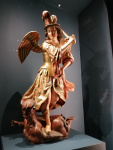

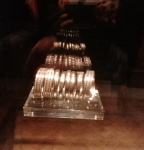
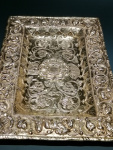
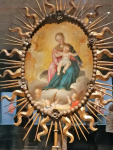
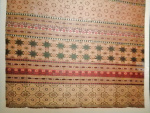
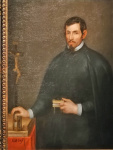

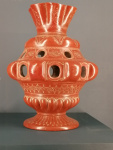







































































By Carla Scarano • art, drawing, exhibitions, painting, sculpture, tapestry, textiles, year 2023 • Tags: art, Carla Scarano, drawing, exhibitions, painting, sculpture, tapestry, textiles